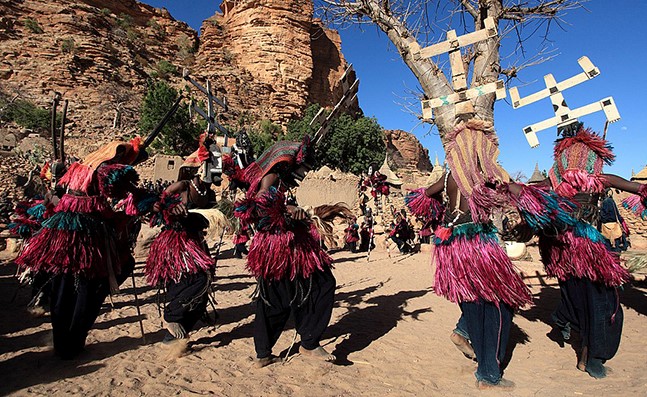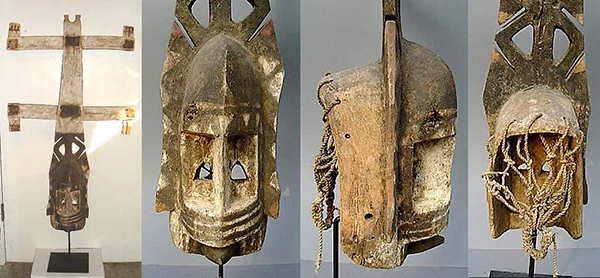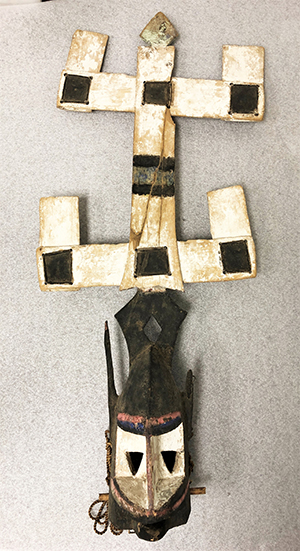Mali: Make A Dogon Mask

Dogon men dance with kanaga masks.
Who are the Dogon?
The Dogon are an ethnic group living in the central region of West Africa, mostly in Mali and Burkina Faso. The Dogon population is about 2 million people. They speak Dogon languages which are not closely related to other languages.
The Dogon are best known for their religious traditions. Fewer than half the Dogon are Muslim, and fewer still are Christian. Most Dogon practice traditional religion. Masks and their mask dances are part of these religious rituals.
Masks

Details of a kanaga mask from the Lam Museum collection
Dogon masks, such as this one are called kanaga. They are worn primarily at dama, which is a collective funerary rite for Dogon men. Preparations for the dama are elaborate and costly so the ritual may be held several years after the death and burial of an individual. The dama culminates with a procession of masked dancers who escort the souls of the dead from the village to their final resting place in the spirit world. The goal of the ritual is to ensure the spirits have safe passage to the world of the ancestors. It also marks the end of the mourning period for the deceased. Today, kanaga masks continue to be worn at dama rituals but are also danced on other occasions, such as national holidays and at demonstrations for tourists.

Another kanaga mask from the Lam Museum collection
Kanaga masks, like many other Dogon wooden masks, depict the face as a rectangular box with deeply hollowed channels for the eyes. Because the Dogon use many types of masks, it is the structure above the face that identifies this mask as a kanaga. A kaanga mask has a double-barred cross with short vertical elements projecting from the ends of each horizontal bar.
The Dogon have a complex belief system so this form has been interpreted several ways. First, as a literal interpretation of a bird with white wings and a black forehead. On a deeper level the mask is a symbol of god with the crossbars being his arms and legs. Another interpretation is the upper crossbar represents the sky and the lower one, the earth.
When the mask is worn, the dancer wears specific regalia. The back of the dancer’s head is covered with a hood of plaited fibers. He wears a vest sewn with cowrie-shells. Strands of glass and plastic beads dangles from its edges. The dancer also wears a pair of pants made of indigo-dyed cotton cloth. Over the pants is tied a long skirt of dyed fibers and also a short skirt of dyed fibers.
The kanaga mask is not the only one used in the dama. More than eighty different types of masks have been documented in dama performances. They represent various human characters familiar to the Dogon community, such as hunters, warriors, healers, women, and people from neighboring ethnic groups. The masks may also depict animals, birds, objects, and abstract concepts.
You can watch a National Geographic video about masks and the dama ritual here.
You can see more Dogon masked dancing here.
Let’s Make a Kanaga Mask!
Because each kanaga mask is made by hand they are all different. Using the images above as inspiration or your own ideas you can create your own.
You will need:
• Newspaper or copy paper (to make a template)
• Cardboard or heavy poster board (to make mask)
• Pencil
• Eraser
• Maker
• Scissors
• Tape or glue
• Dowels or paint stirrers
• Hole punch
• String or yarn
• Cup for water
• Paintbrushes
• Craft paints (white, black, any others you want)
Steps:
- Fold newspaper/paper in half.

- Using your pencil draw a square face shape on the fold. Each kanaga mask is different so play with the shape until you have one you like.
- Once you have a shape, cut it out.
- Fold your cardboard/poster board in half.
- Using the paper template you made, with the marker trace your mask shape on the fold of the cardboard/poster board.
- Cut it out. Don’t forget to cut out the eyes.
- From the cardboard/poster board cut out 3 long pieces: 1 for the vertical part of the cross and 2 for the horizontal arms of the cross. Cut out 4 small pieces for the ends of the horizontal arms.
- Tape or glue the pieces together to create the cross.
- Tape or glue the cross to the top of your mask.
- Tape dowel/paint stirrers to your cross pieces to make them stiff.
- Paint your mask. Remember there is no one way to paint your mask. Each is unique.
- After your mask has dried, punch 2 holes in either side. Tie string or yarn in the hole so you can tie your mask on.
- Enjoy your kanaga mask!
